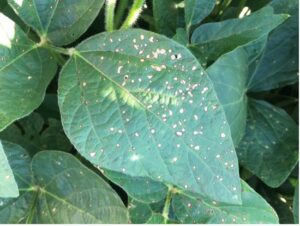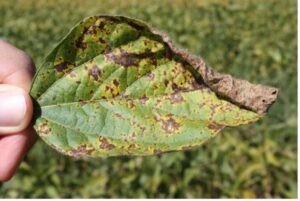What maturity is best to apply a foliar fungicide in soybeans for biggest results?
The soybean maturity best suited for a foliar fungicide application depends on crop history, growing conditions, and the number of applications made. Crop history is one part of this decision based on how long one crop has grown in that field. Continual planting without rotation increases most fungal disease threats, alongside in-season conditions as the other part in this decision depending on soil conditions when planting, and if conditions were continually wet or overly humid during growth, which increases fungal disease chances. In a single application system, a foliar fungicide applied in R3 protects from fungal diseases throughout the rest of the growing season. In a two-stage foliar fungicide application, the first applications happen in R1 or R2 and the second in R3 or R4.
Should I consider using a foliar fungicide?
The 2022 growing season is going by fast, and we are quickly moving to an important decision when it comes to soybeans. Foliar fungicide application has become a regular input on many farms due to earlier planting dates, planting into colder, wetter soils, and fungal diseases becoming more prevalent later in the season along with the benefits from applying fungicide. A foliar fungicide application of soybeans causes little to no increase in seed moisture, unlike corn, but stems do stay green longer even when seed is at the correct moisture. A solution to this is for farmers to choose maturities proper for their location and not pick higher maturity soybeans for their area. From personal experience, this is not optimal and will cause slower harvest speeds and increase stress on combines.
What should be the goal when deciding to apply a foliar fungicide?
The goal of a foliar fungicide application is invariably protecting yield by preventing fungus from injuring, which helps soybeans yield. A few examples of common fungal diseases found in Illinois fields that foliar fungicide thwart include: (Frogeye Leaf Spot and Septoria Brown Rot (pictured below) among others (Chilvers, Managing soybean diseases with foliar fungicide applications 2014). Applying a preventative method, one could predict down to the basic level that keeping the leaves clean of blemishes for a longer part of the season would help the soybeans perform better, photosynthesis ability to continue, and ensuring the plants are healthier in a critical time of the growing season.

Frogeye Leaf Spot

Septoria Brown Rot
Do soybean yields improve with the proper timing of a foliar fungicide application?
The short answer is yes, but how much has been studied by different seed companies, institutions, application companies, and farmers spending a significant amount of time and effort to find out what yield increases are possible. On our family farm in 2021, we tested a foliar fungicide application versus a non-foliar application in a trial where the foliar fungicide was applied well into R3 maturity, and the results averaged a 7-bushel yield gain from the foliar fungicide applied to soybeans versus the non-foliar treated soybeans. According to a 2020 Beck’s Hybrids trial, Beck’s saw an improvement in soybean yields anywhere from 1.0 bushels to 4.7 bushels based on which type of fungicide was used (2020 Central Illinois Soybean Fungicide Study – Foliar 2020).
Does the gain in yield outweigh the cost of application?
Calculating the benefits vs. cost in the example above on our farm, the price when we sold was $12.85 per bushel times the 7-bushel yield gain equals nearly $90 more an acre on the foliar-applied part versus the non-foliar applied. The application cost for this foliar fungicide application was $37 per acre, which is nearly 2.5 times per acre increase! According to the 2020 Beck’s trial, the treatment costs of a few treatments would not be returned based on the results and the ones that did were single digit per acre gains.
Sources
Central Illinois. (2020). 2020 Central Illinois Soybean Fungicide Study – Foliar. Practical Farm Research. Retrieved July 10, 2022, from https://www.beckshybrids.com/pfresearch/Detail/ArtMID/1316/ArticleID/3339/2020-Central-Illinois-Soybean-Fungicide-Study-Foliar
Chilvers, M. (2014, July 14). Managing soybean diseases with foliar fungicide applications. Soybeans. Retrieved July 10, 2022, from https://www.canr.msu.edu/news/managing-soybean-diseases-with-foliar-fungicide-applications


 and then
and then